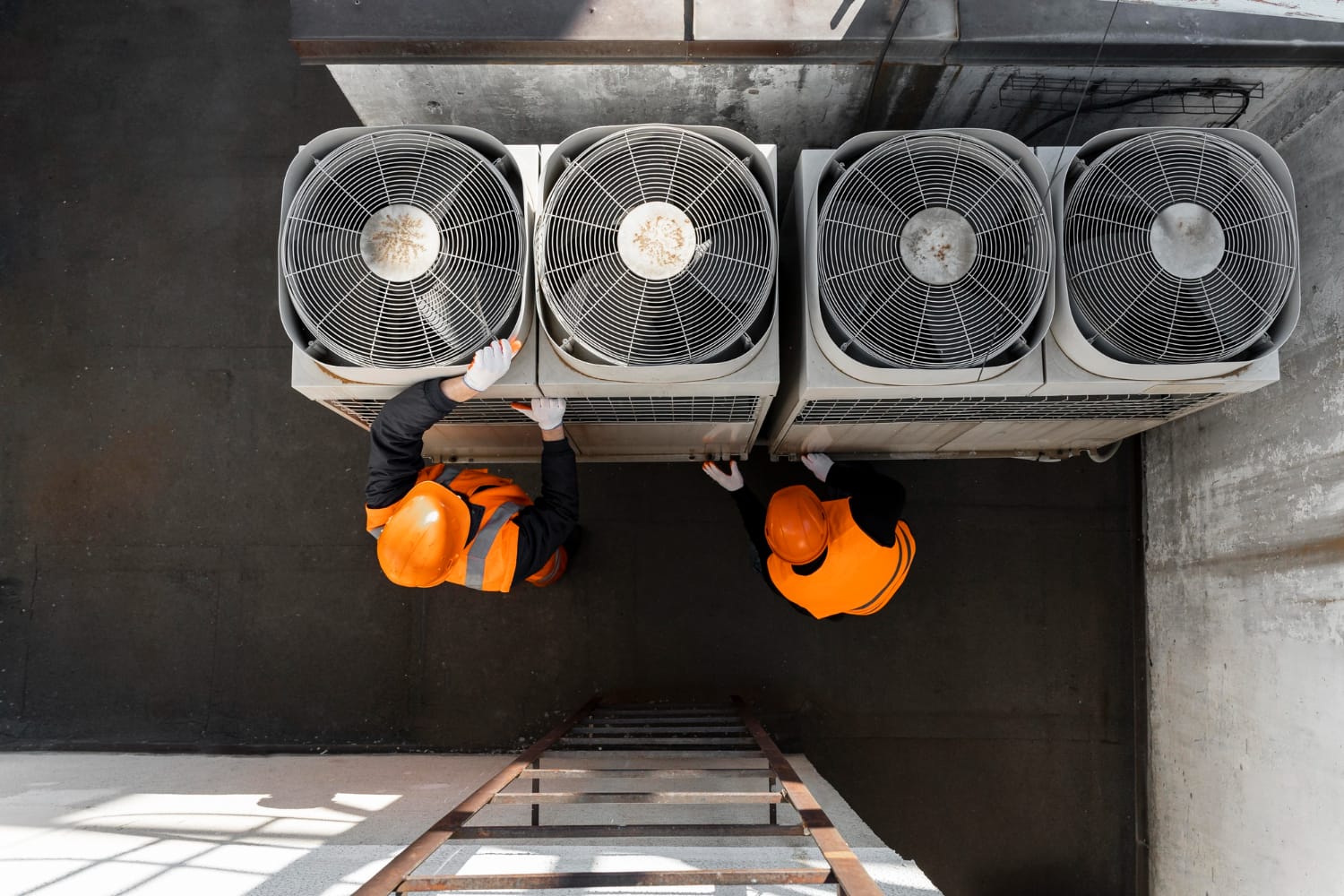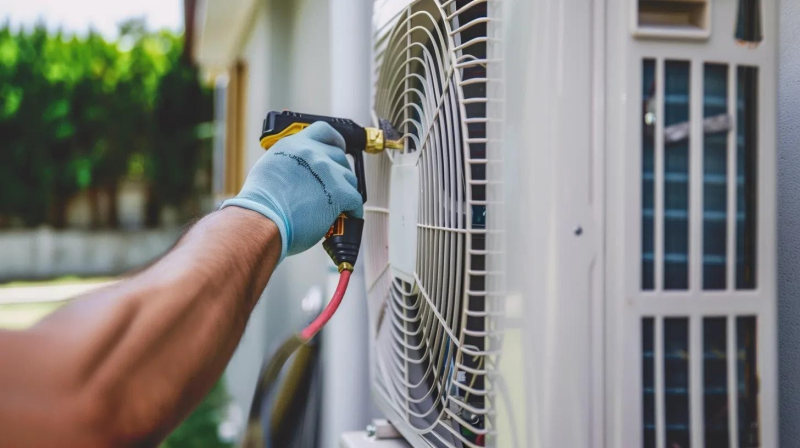Cuando se trata de mantener una temperatura confortable en su hogar o negocio, C.A. El sistema nervioso juega un papel crucial. Pero ¿te has preguntado alguna vez qué hace que tu C.A. ¿La unidad funciona de manera tan eficiente?
La respuesta se encuentra en un componente clave conocido como C.A. refrigerante.
Esta sustancia mágica es responsable de absorber el calor del aire interior y liberarlo al exterior, refrescando así el espacio. Sin embargo, no todos... C.A. Los refrigerantes son creados iguales.
En esta guía, profundizaremos en la comprensión de los diferentes tipos de C.A. Refrigerantes. Exploraremos los diferentes tipos, sus usos y las consideraciones a tener en cuenta al trabajar con ellos.
Ya sea que sea propietario de una pequeña empresa, un profesional que trabaja desde casa o una madre que se queda en casa, esta guía le brindará el conocimiento que necesita para tomar decisiones informadas sobre su C.A. sistema.

¿Qué es el refrigerante AC?
C.A. El refrigerante es un fluido especial que circula por el aire acondicionado. Es el elemento vital del sistema de refrigeración, trabajando incansablemente entre bastidores.
La función principal del refrigerante es absorber el calor del interior y expulsarlo al exterior. Al absorber calor, cambia entre los estados líquido y gaseoso, lo que permite una transferencia de calor eficaz.
Este proceso mantiene el aire interior fresco y confortable, incluso en los días más calurosos. Sin refrigerante, su sistema de aire acondicionado no podría enfriar su hogar u oficina.
Existen diversos tipos de refrigerantes, cada uno con propiedades únicas. Desempeñan un papel crucial en la eficiencia de refrigeración y el impacto ambiental.
Comprender estos tipos puede ayudarle a mantener mejor su sistema de refrigeración. Además, le garantiza el cumplimiento de las normativas ambientales que protegen nuestro planeta.
Tipos comunes de refrigerantes de aire acondicionado
Diferentes refrigerantes desempeñan diferentes funciones en aire acondicionado sistemas. Cada uno tiene propiedades y regulaciones específicas en torno a su uso.

R-22 (clorodifluorometano o freón)
El R-22, también conocido como freón, fue en su día un refrigerante popular. En los sistemas de aire acondicionado más antiguos, sigue siendo bastante común.
Sin embargo, el R-22 se está eliminando gradualmente debido a sus propiedades destructoras de la capa de ozono. Es importante que los propietarios de aires acondicionados lo tengan en cuenta.
Si su sistema utiliza R-22, considere consultar alternativas con un profesional. Este podrá orientarle en la transición a opciones más ecológicas.
R-410A (Purón)
El R-410A, o Puron, es un refrigerante más ecológico. Actualmente es estándar en muchos sistemas modernos.
Este refrigerante no daña la capa de ozono, a diferencia del R-22. Por ello, se ha adoptado ampliamente en las unidades de refrigeración más modernas.
Elegir sistemas con R-410A garantiza el cumplimiento de la normativa ambiental. Esto ayuda a reducir su huella ecológica.
R-32 (difluorometano)
El R-32 está ganando popularidad como alternativa eficiente. Ofrece una mayor eficiencia de refrigeración con un menor potencial de calentamiento global.
Además, el R-32 utiliza menos volumen de refrigerante para la misma potencia de enfriamiento, lo que lo convierte en una opción rentable.
Aunque es relativamente nuevo, muchos fabricantes están adoptando el R-32 en sus modelos más recientes. Es una opción prometedora para los consumidores con conciencia ecológica.
Otros refrigerantes notables
A continuación se presenta una breve descripción general de otros refrigerantes:
- R-134a es común en los vehículos aire acondicionado, conocido por su estabilidad.
- R-1234yf Es una alternativa más novedosa para los sistemas de los automóviles, que reduce el impacto ambiental.
- R-407c Imita las propiedades del R-22 y se utiliza en unidades modernizadas.
Los sistemas modernos se inclinan por mezclas o refrigerantes más nuevos. Estas opciones se ajustan mejor a las normas ambientales y ofrecen mayor eficiencia.
Mantenerse informado sobre los tipos de refrigerantes puede ayudarle a tomar mejores decisiones para su unidad de aire acondicionado. Comprender los impactos, los costos y la eficiencia beneficia a todos los propietarios.
Consultar con un certificado Climatización Un profesional puede simplificar estas elecciones y garantizar el cumplimiento de las normas actuales.
Impacto ambiental y normativa
Los refrigerantes juegan un papel fundamental en aire acondicionado pero también tienen impactos ambientales. Comprenderlos puede guiarte para tomar mejores decisiones.
Históricamente, muchos refrigerantes han contribuido al agotamiento de la capa de ozono y al cambio climático. El R-22 es un ejemplo significativo de este problema. Estos impactos impulsaron iniciativas globales para reducir el daño ambiental.
Regulaciones como el Protocolo de Montreal han allanado el camino para alternativas ecológicas. Este tratado internacional busca eliminar gradualmente las sustancias que dañan la capa de ozono.
Los fabricantes ahora se centran en el desarrollo de refrigerantes con menor potencial de calentamiento global. Este cambio no solo protege el medio ambiente, sino que también cumple con las normas legales.
Como consumidores, estar al tanto de estos cambios contribuye a garantizar el cumplimiento normativo y la sostenibilidad. También es fundamental buscar asesoramiento profesional para cualquier inquietud relacionada con el refrigerante o la actualización del sistema.
La eliminación progresiva del R-22
El R-22 fue alguna vez un refrigerante ampliamente utilizado en aire acondicionado sistemas. Sin embargo, debido a su potencial de destrucción de la capa de ozono, se está eliminando gradualmente.
En 2020, la producción e importación de R-22 se suspendieron en gran medida. Los sistemas existentes aún pueden funcionar con R-22, pero los suministros están disminuyendo.
Se recomienda cambiar a R-410A u otros refrigerantes ecológicos. Consultar con un... Climatización Un experto puede facilitar esta transición. Se asegurará de que su aire acondicionado cumpla con las normas vigentes.
Refrigerantes nuevos y ecológicos
Los refrigerantes más nuevos están diseñados para minimizar el impacto ambiental. El R-410A, por ejemplo, ofrece una refrigeración eficiente sin dañar la capa de ozono.
Además, opciones como el R-32 y el R-1234yf presentan potenciales de calentamiento global aún menores. Estas alternativas demuestran un cambio significativo hacia la sostenibilidad.
La incorporación de estos refrigerantes reduce la huella de carbono de su sistema. Esta transición es un paso eficaz hacia soluciones de refrigeración más respetuosas con el medio ambiente.
Colaborar con profesionales garantiza el manejo correcto de estos refrigerantes. Esto ayuda a garantizar que los sistemas funcionen de forma segura y eficiente, a la vez que protegen nuestro planeta.
Cómo identificar el tipo de refrigerante de su aire acondicionado
Es importante identificar el tipo de refrigerante que usa su unidad de aire acondicionado. Esta información facilita el mantenimiento y la actualización a sistemas más nuevos. Afortunadamente, no es tan difícil de averiguar.
Primero, revise la etiqueta de su unidad de aire acondicionado. Los fabricantes suelen indicar el tipo de refrigerante en la unidad, generalmente en una pegatina. Esta pegatina suele encontrarse cerca de los puertos de servicio o en el compresor.
Si la etiqueta no está presente o es ilegible, consulte el manual de usuario de su unidad. El manual debe especificar el tipo de refrigerante utilizado. Este paso puede ser especialmente útil si se trata de una unidad antigua.
Para unidades sin documentación clara, contacte con un profesional. Climatización Un técnico puede identificar el tipo de refrigerante adecuado para usted. También puede recomendarle las opciones más adecuadas si está considerando una actualización. Conocer el tipo de refrigerante le garantiza un uso eficiente de su sistema de aire acondicionado y que cumple con las normas vigentes.
Cuándo llamar a un profesional por problemas con el refrigerante del aire acondicionado
Los sistemas de aire acondicionado pueden ser complicados. Cuando surgen problemas con el refrigerante, es fundamental saber cuándo llamar a un profesional. Estos expertos poseen las habilidades necesarias para manejar situaciones complejas.
Una señal importante de que necesita ayuda profesional es cuando su unidad de aire acondicionado expulsa aire caliente. Es un indicador común de niveles bajos de refrigerante. Las fluctuaciones de temperatura también pueden indicar un problema, posiblemente una fuga.
Además, los silbidos o burbujeos inusuales suelen indicar una fuga de refrigerante. Estos sonidos requieren atención inmediata para evitar daños mayores. Los profesionales cuentan con las herramientas para detectar y... reparar Estas fugas de manera eficiente.
Además, si nota que se forma hielo en las bobinas del evaporador, es probable que haya un problema con el refrigerante. Esto debería motivar una llamada a un técnico. Climatización Técnico. Una acción rápida puede evitar reparaciones más costosas en el futuro.
Finalmente, a la hora de recargar su sistema de aire acondicionado, es recomendable consultar con un profesional. El manejo de refrigerantes requiere mediciones precisas y el cumplimiento de las normas de seguridad. Esto garantiza que su sistema funcione de forma óptima y segura para todos los involucrados.
Señales de niveles bajos de refrigerante
Reconocer las señales de niveles bajos de refrigerante es crucial. Una señal común es la reducción de la eficiencia de refrigeración. Si su aire acondicionado no enfría como antes, revise el refrigerante.
Otro indicador es un aumento en sus facturas de energía. Un nivel bajo de refrigerante hace que su aire acondicionado trabaje más, lo que resulta en costos más altos. Esté atento a cualquier aumento repentino sin explicación.
Por último, la acumulación de hielo en los serpentines indica niveles bajos de refrigerante. Esto no es normal y debe solucionarse de inmediato. Consultar a un profesional puede resolver rápidamente estos problemas y restaurar su comodidad.
Los peligros de manipular refrigerantes por cuenta propia
Manipular refrigerantes por cuenta propia puede ser arriesgado. Los refrigerantes están sometidos a alta presión y pueden causar lesiones graves si no se manipulan correctamente.
Además, la ley exige certificación para trabajar con refrigerantes. Manipularlos sin la certificación adecuada puede acarrear problemas legales. Es mejor dejar esto en manos de profesionales certificados.
Intentar realizar reparaciones por cuenta propia también podría anular las garantías. Los fabricantes suelen especificar que solo técnicos certificados deben manipular refrigerantes. Para proteger su inversión, es recomendable optar por un servicio profesional.
Costo del refrigerante de aire acondicionado para el hogar y el automóvil
Comprender el costo del refrigerante del aire acondicionado puede ayudarle a planificar los gastos de mantenimiento. Tanto los sistemas de aire acondicionado domésticos como los de automóvil pueden necesitar una recarga en algún momento.
Para los sistemas de aire acondicionado domésticos, el costo del refrigerante varía según el tipo. El R-22, aunque se ha descontinuado, puede ser más caro debido a su disponibilidad limitada. El R-410A es una opción común y suele ser más asequible.
En los sistemas de aire acondicionado de automóviles, el costo depende del tipo de refrigerante y del modelo del vehículo. El R-134a es estándar en muchos automóviles, ofreciendo un equilibrio entre rendimiento y precio. Los automóviles más nuevos pueden usar el R-1234yf ecológico, que puede ser más costoso.
Es fundamental tener en cuenta los costos de mano de obra al elaborar el presupuesto. Los cargos por servicios profesionales varían según la ubicación y el proveedor. Solicite siempre un presupuesto detallado antes de proceder con las reparaciones para evitar sorpresas.
Costos del refrigerante del aire acondicionado doméstico
Para los propietarios de viviendas, el costo de reemplazar el refrigerante depende de varios factores. El tipo de refrigerante es un factor importante. El R-410A, una opción residencial común, suele ser más económico que el R-22.
Además, los costos pueden variar según la cantidad requerida. Los sistemas más grandes requieren más refrigerante, lo que afecta el precio total. Siempre consulte con un Climatización profesional para obtener una evaluación de costos precisa.
Costos del refrigerante del aire acondicionado del automóvil
En el sector automotriz, los costos de los refrigerantes pueden variar considerablemente. La mayoría de los autos utilizan el R-134a, que es relativamente económico. Sin embargo, los costos de mano de obra también influyen en el gasto total.
Los vehículos más nuevos podrían requerir R-1234yf. Aunque es más caro, es un producto ecológico. Recuerde que, por seguridad y eficiencia, es mejor recargar el aire acondicionado de su coche con técnicos certificados.
Una cotización precisa de su proveedor de servicios automotrices le brindará claridad sobre los gastos previstos. Esto ayuda a evitar sorpresas innecesarias y garantiza un proceso sin complicaciones.
Mantenimiento de su sistema de aire acondicionado y prevención de problemas con el refrigerante
El mantenimiento regular es fundamental para evitar problemas de refrigerante en su sistema de aire acondicionado. Garantiza la eficiencia y prolonga la vida útil de su unidad.
En primer lugar, programe chequeos anuales con un profesional calificado. Climatización Técnico. Pueden detectar problemas potenciales a tiempo y evitar reparaciones costosas. Las inspecciones regulares cubren los niveles de refrigerante, los componentes eléctricos y el rendimiento general del sistema.
Además, mantenga el área alrededor de su unidad de aire acondicionado limpia y sin residuos. Esto ayuda a mejorar el flujo de aire y la eficiencia del sistema. Recorte las plantas o arbustos cerca de las unidades exteriores para asegurar una ventilación adecuada.

Considere invertir en un termostato programable. Esto no solo mejora la comodidad, sino que también optimiza el consumo de energía. Al reducir la carga innecesaria del sistema, ayuda a prevenir fugas de refrigerante y otras averías.
Por último, preste atención a cualquier ruido extraño o a una menor eficiencia de refrigeración. Estos pueden indicar problemas con el refrigerante. La detección temprana ahorra dinero y garantiza que su hogar u oficina se mantengan cómodos todo el año.
Conclusión y asistencia profesional: comprensión de los diferentes tipos de refrigerantes de aire acondicionado
Comprender los refrigerantes de aire acondicionado es vital para el mantenimiento de sus sistemas de refrigeración. Conocer los tipos y sus efectos le permitirá tomar decisiones informadas. Sin embargo, es mejor dejar el manejo de refrigerantes en manos de profesionales debido a su complejidad.
La asistencia profesional garantiza la seguridad y el cumplimiento normativo. Nuestros expertos manipulan los refrigerantes correctamente, previniendo fugas y daños en el sistema. El mantenimiento profesional regular le evitará averías frecuentes y prolongará la vida útil de su aire acondicionado.
Para un servicio confiable y atención experta, no dude en buscar asistencia profesional.
Contacte con LC Calefacción y Aire Acondicionado en Hollywood
Si estás en el Los Ángeles Área, LC Calefacción y Aire acondicionado Estamos aquí para ayudarle. Llámenos al (123) 456-7890 para obtener servicios de aire acondicionado expertos adaptados a sus necesidades. Confíe en nosotros para mantener su hogar o negocio confortable todo el año.


